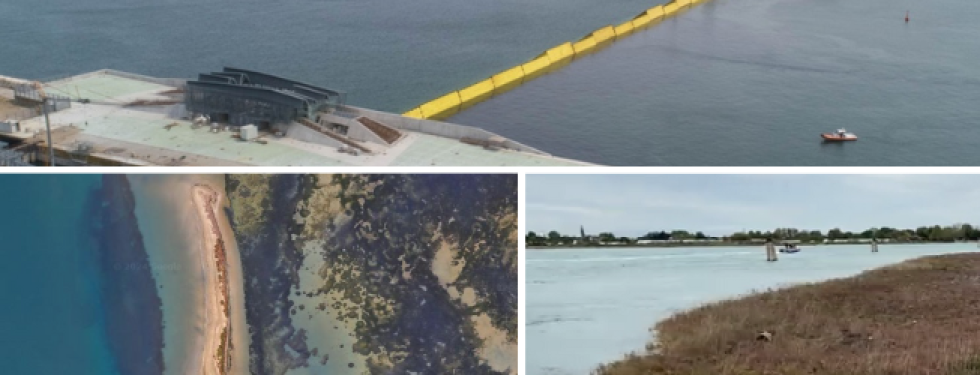A Sand Island and a Sea of Doubts: The Effects of the Mo.S.E. on the Venice Lagoon

The recent news of the formation of a new "island" – or rather, a thin strip of intertidal deposits – near Bacàn has reignited the debate about the effects of the Mo.S.E. system on the morphology and ecosystem of the Venice Lagoon.
Some argue that the Mo.S.E. is responsible for the creation and stability of this "island," claiming it supports the development and maintenance of salt marshes. However, this interpretation is a rather far-fetched leap, as it contradicts scientific evidence from recent studies based on remote sensing data, field experiments, laboratory analyses, and morphodynamic model results.
It has been recently demonstrated that the salt marshes of the Venice Lagoon grow primarily – accounting for 70% of total deposition – during storm surges (Tognin et al., 2021, Nature Geoscience). While the Mo.S.E. activations are essential to protect Venice from extreme tides, they drastically reduce tidal peaks and significantly limit the extent and duration of marsh submersion during storm surges. This inevitably leads to reduced sediment supply to the marshes, threatening their long-term survival.
Further modeling studies (Tognin et al., 2022, Science Advances) confirm that while the Mo.S.E. is crucial for protecting Venice, it promotes the morphological degradation of the lagoon. It causes the flattening and dissolution of its characteristic morphological structures, such as shallow bottoms, salt marshes, and channel networks, reducing the lagoon's morphological diversity.
Satellite images available on Google Earth clearly show that the vertical growth and lateral expansion of the Bacàn sediment strip preceded the Mo.S.E.’s first activation to protect Venice from high tides on October 3, 2020. The development of this strip of sand and mud is the result of purely local dynamics that favored its vertical growth and lateral spread. The subsequent colonization by halophytic vegetation accelerated the strip's stabilization, thanks to the well-known eco-morphodynamic feedback between physical and biotic processes in lagoon environments.
Morphodynamic models developed since the 1990s by the hydraulic research group at the ICEA Department (Luigi D’Alpaos, Andrea Defina, and Luca Carniello) also highlight the presence of an area of sediment deposition near Bacàn. However, this phenomenon is highly localized and linked to particularly favorable hydrodynamic conditions, which cannot be considered representative of the entire lagoon. Recent simulations reveal that the reduction in lagoon water levels due to Mo.S.E. activations has a limited effect on attenuating wind-wave heights around the “new islet” of Bacàn. This area is already naturally protected from Bora wind waves by the true island northeast of the “new islet” and from Scirocco wind waves by the artificial island serving as an intermediate structure between the two rows of movable gates at the Lido inlet. Paradoxically, the reduction in water levels negatively impacts wind-induced bottom stresses, which are even intensified, leading to increased erosion (Tognin et al., 2022, Science Advances).
Attributing the formation of Bacàn to Mo.S.E. closures is thus a diversionary hypothesis. The development of an expanding ecosystem on Bacàn is not necessarily a sign of natural recovery for the lagoon. It does not challenge the findings of previous studies or demonstrate that the Mo.S.E. promotes the evolutionary dynamics of salt marshes. On the contrary, it underscores the importance of considering the delicate balance between human interventions and natural dynamics and fostering an accurate understanding of the Mo.S.E.’s effects.
The Mo.S.E. system plays a crucial role in protecting Venice from high tides. However, it is essential to recognize that tidal regulation at the inlets does not offer comparable benefits to the lagoon ecosystem. On the contrary, Mo.S.E. closures accelerate the degradation process of the lagoon, generating negative environmental impacts that require appropriate compensatory and mitigation measures. A balanced evaluation of these impacts would enable the development and implementation of targeted strategies for ecosystem conservation and restoration.
Sustainable management of the Venice Lagoon requires an approach that balances the city's protection with the preservation of the lagoon ecosystem, actively addressing the collateral effects of the implemented safeguarding measures.
Andrea D'Alpaos (Full Professor - Department of Geosciences)





